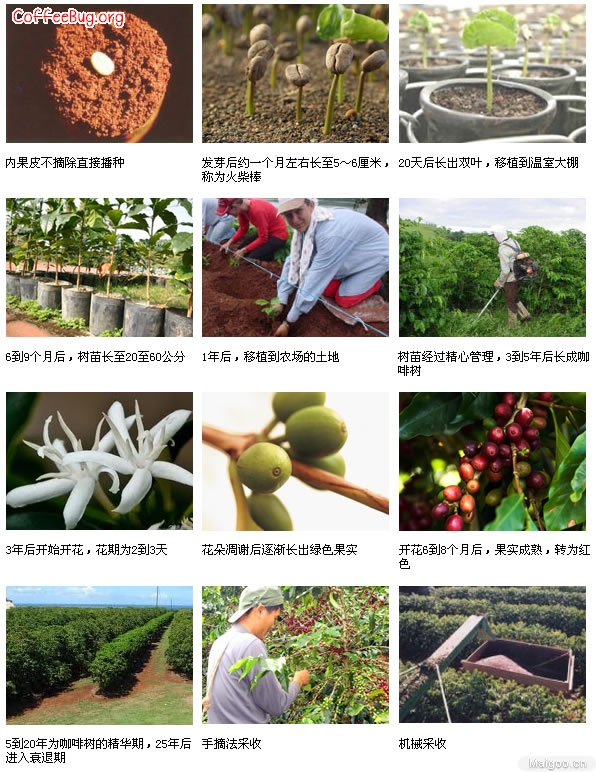The cultivation process of Coffee beans: sowing and harvesting course

For professional baristas, please follow the coffee workshop (Wechat official account cafe_style)
The cultivation process of Coffee
People often mistakenly think that coffee is grown directly with raw beans, but it takes a long time to grow coffee only to find that it doesn't sprout. In fact, coffee is grown with seeds with endocarp (Parchment). "Inner fruit" (or "sheepskin" or "paper skin") refers to the tea-brown hard skin that wraps the coffee seeds, and the coffee beans attached to that layer are called "Parchment Bean".
Plucking the skin of the fully ripe bright red coffee fruit (called red cherry), you can see that there is yellow flesh under the red skin, which is a bit like a cherry, the flesh is sweet, there is a pair of symmetrical seeds in the center, and there is a slippery film around the seeds. Wash the film off with water to become "shelled beans". Peel off the endocarp and you will see the seeds covered with Silver Skin. The seed is the raw bean actually used as the raw material of coffee.
1. Sowing seeds
The coffee wrapped with endocarp will be planted in the seedbed (a plastic flowerpot called "pot") and will germinate in 40 to 60 days and grow to about 50 centimeters in about 6 months after germination. At this stage, the seedlings are still fragile and must be covered with cold gauze and other things to block direct sunlight.
The seedlings blossomed about three years after they were transplanted from the seedbed to the garden. During this period, countries such as Central America that use hand-picking to harvest coffee beans will prune the branches of coffee trees and remove the lower side branches in order to improve the efficiency of harvesting coffee. The flowers of the coffee tree are white five-petal flowers with a jasmine scent. The flowers wither in a few days, then grow small fruits, and turn red in 6 to 8 months to represent maturity.
The peak of the coffee harvest is in the 6-10 years after the coffee tree grows, and then the harvest will gradually decline. In addition, if the coffee tree grows too high, it will also lead to a poor harvest, so coffee farmers will cut off the trunk from 30cm to 50cm above the ground, allowing it to regenerate branches and renew productivity. This step is called "Cutback". If combined with climate, fertilization, resistance to diseases and insect pests and other favorable conditions, coffee trees can last 20 years, or even 50 years of continuous fruit.
Wild coffee trees can be as high as 10 meters, but generally planted coffee trees are maintained at a height of about 2 meters in order to harvest conveniently. Arabica coffee varieties are being improved year after year, hoping to reach the level of high harvest, high virus resistance, early harvest, strong environmental adaptability, and, of course, the appropriate height of trees to make harvesting more efficient.
two。 Harvest
The harvest time and method of coffee vary from place to place, generally speaking, about once or twice a year (sometimes up to three or four times). The harvest time is mostly in the dry season. In Brazil, for example, around June, it starts in the north-eastern state of Bahia and ends in October in the southern state of Parana. The harvest period of Central American countries is from September to January of the following year, from lowlands to highlands.
Harvesting methods can be divided into two categories, one is hand picking method, the other is shaking method.
(1) hand picking
With the exception of Brazil and Ethiopia, most Arabica coffee-producing countries are harvested by hand. Hand picking involves not only picking ripe bright red coffee fruits, but also sometimes along with immature cyan coffee fruits and branches, so these immature beans are often mixed with refined coffee beans, especially when refined by natural methods. If these beans are mixed with baking, they will produce a disgusting stench.
(2) shake-down method
This method is to hit the ripe fruit or shake the coffee branch with a random stick, so that the fruit falls and accumulates into a pile. Larger estates will use large harvesters, while small and medium-sized farms will harvest with a sea of people mobilized by the whole family. This method of shaking the fruit off the ground is easier to mix with impurities and defective beans than the hand-picking method, and beans from some places can be stained with a strange smell or fermented because the ground is wet. Producers of Robusta coffee beans such as Brazil and Ethiopia are mostly harvested in this way.
Countries harvested by shaking and falling method also use natural drying method to refine coffee beans. Coffee blossoms in spring, bears fruit in summer and harvests in winter, so it is very difficult to harvest and dry in places where there is no clear distinction between drought and rainy seasons. in the rainy season, it is impossible to use natural drying. Therefore, coffee is suitable for growing in areas with distinct dry and rainy seasons.
Important Notice :
前街咖啡 FrontStreet Coffee has moved to new addredd:
FrontStreet Coffee Address: 315,Donghua East Road,GuangZhou
Tel:020 38364473
- Prev

How to distinguish good coffee beans? Beans ripe enough, beans dry phase, aroma can not last!
Professional barista communication Please pay attention to coffee workshop (Weixin Official Accounts cafe_style) Coffee is a must-drink drink for many people every day, but are you drinking it right? How to distinguish fresh coffee beans, teach you from the color appearance and taste of coffee beans are good or bad. After buying coffee beans, how to preserve it also has some knowledge! Good bean characteristics: ripe enough, beans coherent, aroma is not lasting
- Next

[practical information] how are coffee beans screened and graded?
Communication of professional baristas Please pay attention to the grading of coffee in the coffee workshop (Wechat official account cafe_style). If the owners of two cafes are discussing, owner A says: the coffee beans we use in our shop are NO.2 in Santos, Brazil. Where is your shop? B the shopkeeper said: our store uses Brazilian NO.1 of the same level as Blue Mountain NO.1. The evaluation method adopted in Brazil is the deduction method, according to every 300 grams.
Related
- Beginners will see the "Coffee pull flower" guide!
- What is the difference between ice blog purified milk and ordinary milk coffee?
- Why is the Philippines the largest producer of crops in Liberia?
- For coffee extraction, should the fine powder be retained?
- How does extracted espresso fill pressed powder? How much strength does it take to press the powder?
- How to make jasmine cold extract coffee? Is the jasmine + latte good?
- Will this little toy really make the coffee taste better? How does Lily Drip affect coffee extraction?
- Will the action of slapping the filter cup also affect coffee extraction?
- What's the difference between powder-to-water ratio and powder-to-liquid ratio?
- What is the Ethiopian local species? What does it have to do with Heirloom native species?

